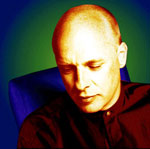
For Eno was already using the studio as a compositional tool [predating many ideas of remix], listening to world music [predating the whole world music explosion in the late 70s], using both improvisers and non-musicians to give his music a strange and quirky edge, and feeding the conceptual ideas of Cornelius Cardew and John Cage into his music; he was basically on the case and ahead of the game.
The four Eno LPs just getting the CD reissue treatment are often referred to as his first four albums post Roxy Music, and seen as a quartet of song albums. Neither statements are true. Eno had already issued a duo LP with Robert Fripp before …Warm Jets, and interwoven between Taking Tiger Mountain…, Another Green World and Before and after Science, we find not only the second Fripp and Eno album of fragile loops and drones, but Eno’s own Discreet Music the title track of which would lay the foundation for much of his later ambient work. His name would also appear on the June 1, 1974 LP, where he played alongside various Island Records stablemates, and on Phil Manzanera’s 801 projects. And as the four albums go on, there are more and more instrumental and mainly-instrumental tracks.
Listening again to this music one can see why Eno eventually found the idea of producing and collaborating, and of ambient music, far more exciting than making short songs or instrumentals. I’ve never understood why everyone I know along with most critics thinks Another Green World is so great; apart from a couple of riproaring guitar solos by Fripp, I find it earnest, dull and heavy-going it reminds me mostly of the bland jazz-rock that the likes of Brand X were peddling at the time. Before and After Science is still my favourite, but listening to it this morning it is clearly of its time: it has a big production sound, and seems to heavily feature fretless bass. It’s best track, ‘King’s Lead Hat’, is not only an anagram of Talking Heads, but a pale shadow of the music that band would make using a similar combination of new wave funk, minimalism and punk.
And there’s the rub. This is music from the end of rock music; music made before punk, and then later dance, arrived. Eno really came to life as new wave music exploded in New York: he produced an early compilation LP of ‘no wave’ bands, supervised a whole bunch of Television demos, promoted Bill Laswell and the first incarnation of Material, and got stuck in to Talking Heads. He helped make David Bowie’s best three LPs; introduced Jon Hassell to a wider audience; and took cut-up collage funk to the masses with David Byrne on their Bush of Ghosts LP. He got everywhere… including up a lot of people’s noses.
Then, after the exquisite proto-Satie piano sketches of Music for Airports and the aural landscapes of On Land [definitely one of his finest LPs], he drifted into long, minimal ambient music CDs, often in association with video and light installations. Apart from quick diversions such as his collaboration with John Cale, or as a guest singer or musician [as well as producer] on various U2 songs, this is still where Eno lives. Seemingly oblivious to musical whims and fashions, he associates himself with the occasional charity such as War Child, produces occasional CDs from his art shows on his own label, and pops up on TV and in magazines to talk wisely about the future, computers and cybernetics, electronics and synthesizers.
Personally, I wouldn’t have it any other way. My shelf of Eno CDs is one of the most played parts of my music collection; I think the man is a genius. But it is for the later music, along with his production work and writings, that he will be remembered. Don’t get me wrong, there’s some great stuff to listen to on these early records, but principally they are the sound of Eno getting Roxy Music out of his system, and learning to assemble music in the studio. These records show him unknowingly preparing himself to sieze the moment when punk opened up even more possibilities for self-professed ‘non-musicians’ such as himself. Never was there such a firework as Brian Eno once his touchpaper had been lit!
© 2004 Rupert Loydell